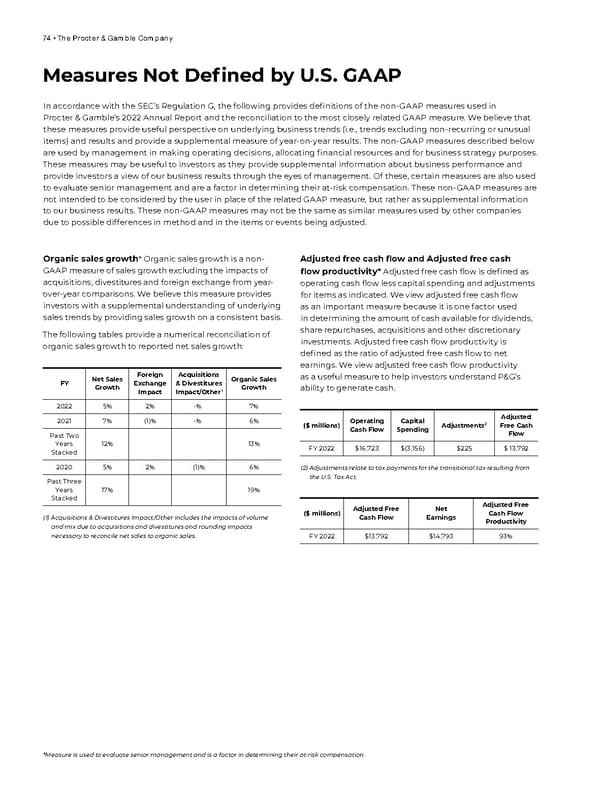Measures Not Defined by U.S. GAAP In accordance with the SEC’s Regulation G, the following provides definitions of the non-GAAP measures used in Procter & Gamble’s 2022 Annual Report and the reconciliation to the most closely related GAAP measure. We believe that these measures provide useful perspective on underlying business trends (i.e., trends excluding non-recurring or unusual items) and results and provide a supplemental measure of year-on-year results. The non-GAAP measures described below are used by management in making operating decisions, allocating financial resources and for business strategy purposes. These measures may be useful to investors as they provide supplemental information about business performance and provide investors a view of our business results through the eyes of management. Of these, certain measures are also used to evaluate senior management and are a factor in determining their at-risk compensation. These non-GAAP measures are not intended to be considered by the user in place of the related GAAP measure, but rather as supplemental information to our business results. These non-GAAP measures may not be the same as similar measures used by other companies due to possible differences in method and in the items or events being adjusted. Organic sales growth * Organic sales growth is a non- GAAP measure of sales growth excluding the impacts of acquisitions, divestitures and foreign exchange from year- over-year comparisons. We believe this measure provides investors with a supplemental understanding of underlying sales trends by providing sales growth on a consistent basis. The following tables provide a numerical reconciliation of organic sales growth to reported net sales growth: FY Net Sales Growth Foreign Exchange Impact Acquisitions & Divestitures Impact/Other 1 Organic Sales Growth 2022 5% 2% -% 7% 2021 7% (1)% -% 6% Past Two Years Stacked 12% 13% 2020 5% 2% (1)% 6% Past Three Years Stacked 17% 19% (1) Acquisitions & Divestitures Impact/Other includes the impacts of volume and mix due to acquisitions and divestitures and rounding impacts necessary to reconcile net sales to organic sales. Adjusted free cash flow and Adjusted free cash flow productivity* Adjusted free cash flow is defined as operating cash flow less capital spending and adjustments for items as indicated. We view adjusted free cash flow as an important measure because it is one factor used in determining the amount of cash available for dividends, share repurchases, acquisitions and other discretionary investments. Adjusted free cash flow productivity is defined as the ratio of adjusted free cash flow to net earnings. We view adjusted free cash flow productivity as a useful measure to help investors understand P&G’s ability to generate cash. ($ millions) Operating Cash Flow Capital Spending Adjustments 2 Adjusted Free Cash Flow FY 2022 $16,723 $(3,156) $225 $ 13,792 (2) Adjustments relate to tax payments for the transitional tax resulting from the U.S. Tax Act. ($ millions) Adjusted Free Cash Flow Net Earnings Adjusted Free Cash Flow Productivity FY 2022 $13,792 $14,793 93% *Measure is used to evaluate senior management and is a factor in determining their at-risk compensation. 74 • The Procter & Gamble Company
 The Procter & Gamble Annual Report Page 85 Page 87
The Procter & Gamble Annual Report Page 85 Page 87